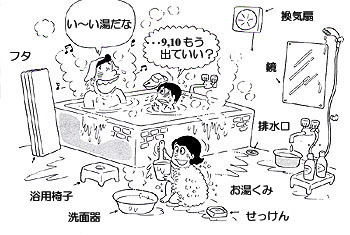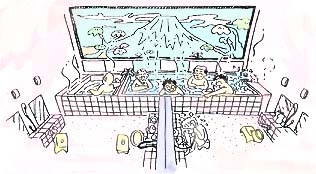
 |
 After returning from a trip abroad, the first thing most Japanese want to do is eat a good meal ( with rice, of course ) and take a long bath. Japanese are fond of soaking in the tub. According to one survey, 88% of Japanese said they liked taking baths. After returning from a trip abroad, the first thing most Japanese want to do is eat a good meal ( with rice, of course ) and take a long bath. Japanese are fond of soaking in the tub. According to one survey, 88% of Japanese said they liked taking baths.In a Japanese bath, an extra-deep tub is filled to the top with very hot water, in which you sit submerged up to the neck. Most people spend about half an hour in the bath every night. Most children take their baths with their father or mother until they are in the upper grades of elementary school. The family tub is an important place for parent-child communication. Why did Japan develop its particular style of bathing? One answer might be the climate. Japan's summers are hot and humid, and its winteres are cold. Hot baths wash the body's sweat off in the summer and warm the body up in the winter. Another answer might be Japan's volcanoes. Japan is famous for its number of volcanoes, many of which are still active. In many places, hot water bubbles up from underground. These hot springs, and the presence of many fast flowing rivers with clean water, have influenced the development of Japan's bath culture. Japanese use their baths not only to get clean but to maintain their health by warming themselves up and stimulating their circulation. Because the body is washed outside the bath, the bath water stays clean and deeply refreshing. In the hot springs or the public bath, everybody bathes in the same water, creating an unclothed companionship that facilitates amiable communication. In a bath, you can relax, recover from exhaustion, rid yourself of stress. No wonder Japanese love their baths. | ||
| Illustration : Yoshiteru Iizuka | ||
Bath Etiquette Here we introduce the standard approach to taking a Japanese bath. In the Japanese "bathroom," a separate room from the toilet, the tub is sunk halfway into the floor. Because the bath water is only used for soaking (not for washing), all members of the family take turns using it. You wash in the area outside of the tub; do not enter the bath unrinsed or wash yourself in the bath water. Towels in the bath are also a no-no (1) Rinse your body off outside the tub. Use a washbowl to scoop hot water out of the tub to rinse yourself with. (2) Get in the bath. The water temperature should be between 38°C and 42°C, and the water should be deep enough that an adult can sit submerged up to the neck. Fifty years ago, tubs were made of wood, but nowadays they are made of tile, plastic, or stainless steel. (3) Get out of the bath, sit down ( on the low stool provided or on your knee(s) -- not, in other words, with your bottom directly on the floor ), and wash yourself thoroughly. You can wash your hair now, too. Use the shower or water from the bath to clean any remaining soap or shampoo from the floor; the floor, which is usually made of tile or plastic, is fitted with a drain, so you may use as much water as you like. (4) Get back into the bath and warm yourself up thoroughly. When you get out, don't pull the plug. Replace the cover over the bath so that the water does not get cold for the next person. | ||
Public Bath (  Sentoo ) Sentoo ) |
 Large public baths are fixtures in many urban neighborhoods. Their existence is recorded as far back as the mid-eighth century, when they began as free bath facilities for the community of people in resistance at large temples. Men and women at this time used the same bath. In the Edo period (1603-1867), about 600 public baths provided washing facilities and places for socializing for the more than one million people who lived in the city of Edo (now Tokyo). Large public baths are fixtures in many urban neighborhoods. Their existence is recorded as far back as the mid-eighth century, when they began as free bath facilities for the community of people in resistance at large temples. Men and women at this time used the same bath. In the Edo period (1603-1867), about 600 public baths provided washing facilities and places for socializing for the more than one million people who lived in the city of Edo (now Tokyo).Public baths were an essential part of most people's lives until the 1970s, by which time most households had their own baths as did many more apartments. The number of public baths nation wide declined from more than 23,000 in 1964 to fewer than 10,000 in 1991. Modern public baths have separate facilities for men and women. Admittance is about 360 yen. Some of the more up-to-date places also have a sauna and other health facilities. Japan is one of the few places in the world where groups of people bathe together. Many people with baths in their own homes still visit the sento in search of a place to socialize with their neighbors. Among the young set, however, bathing communally has become a source of embarrassment, and children on overnight school trips are sometimes seen weaning their bathing suits into the bath. Perhaps Japan's bath culture is changing. |
| Illustration : Urban Life Research Institute, Urban Life Report no15., 1989 |
Hot Springs (  Onsen ) Onsen ) | |
| Hot springs, or onsen, are 25°C or hotter or have a certain amount of mineral content. As of 1990, 2,300 hot springs in Japan met these criteria. Full of sulphur, calcium, sodium, and other minerals, the water is efficacious against rheumatism, high blood pressure, diabetes, and other illnesses. The medical powers of hot springs are recorded as far back as the eighth-century. Buddhist priests also used hot springs as part of a ceremony of publication. The areas around famous hot springs support large resorts with numerous inns and hotels. One can also enjoy nature while soaking in an outdoor hot springs bath known as a rotenburo. Travel magazines often carry special features on hot springs, and hot springs tours run by travel agents are popular with young people and old people. You can try some of the most famous hot springs from the comfort of your own tub. Just tear open a store-bought packet of minerals named after the hot spring of your choice and pour into your bath. But beware -- the color and aroma of such commercial bath salts usually have nothing to do with the real thing. | |
 A pamphlet for an onsen tour |
 |
| Language Immersion : Bath-Inspired Vocabulary |
Yukata (  Bathing Clothes ) Bathing Clothes ) |
| A summer kimono made of cotton. In the Heian period ( 794-1185 ), it was used as an after-bath robe, but by the Edo period it became summer casual wear. Today, yukata are worn both at summer festivals or for fireworks displays and at inns and hotels in place of pajamas. |
Hadaka no Tsukiai (  Naked Companionship ) Naked Companionship ) |
| A friendship in which nothing is hidden, as when people take a bath naked together. |
Furoshiki (  Bath Spread ) Bath Spread ) |
| A 70- to 220-square cm piece of silk or cotton cloth. In the Edo period, people would wrap their washbowls in these clothes to take to the public bath; when they changed clothes they would stand on one of these spread on the floor and then wrap their clothes in the cloth. That's how the furoshiki got its name. This multipuepose cloth can be used to wrap and carry anything of any shape, from vegetables to a jar. Nowadays, the furoshiki has been replaced as a way of carrying things by bags. |
Yumizu (  Hot and Cold Water ) Hot and Cold Water ) |
| Something that is everywhere. Example : He uses money like hot and cold water ( in English : as if it grew on trees; as if it were water). |
| Reference : | Wagaya no Ofuro 50 Nen-shi 1995, Furo Bunka Kenkyuukai There's a Hippo in My Bath ! Kyoko Matsuoka, Illus. Akiko Hayashi, Doubleday & Co., Inc., U.S.A., 1989 |
Original text : The Japan Forum Newsletter no6 "A day in The Life" June 1996.
Send feedback to forum@tjf.or.jp